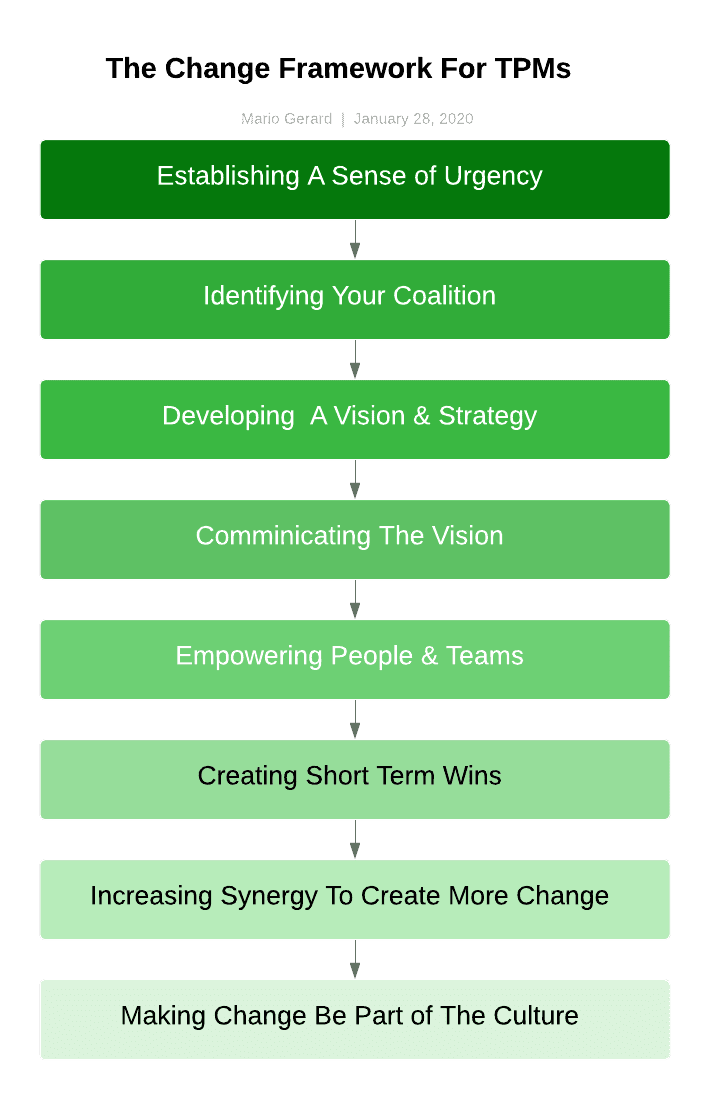Last updated on April 11th, 2023 at 03:14 pm
When you talk to entrepreneurs or startups and organizations that are successful they all have one thing in common. They have been able to pivot from one strategy/idea to another and have a key culture to iterate through ideas. The more I look into this I have realized that successful leaders embrace and drive change to be successful. This post is primarily going to focus on how you as a Technical Program Manager can implement change as well as be the leader who goes about changing and transforming the organization you work at.
As TPMs it is your responsibility to lead or to propose change. You are the CEO of your business however big or small it might be. You need to understand how you can empower your leaders to drive and roll out the change. Remember that if you want something to happen it needs to start with YOU driving it. You are the captain of your ship.
In this post, I detail a framework that will give you an overview of things you would need to keep in mind while rolling out a change within your organization. Also, pay close attention to the order of the framework below. It is imperative that the steps mentioned are carried out in sequence.

STEP 1: Establishing A Sense of Urgency
Creating a sense of urgency when driving change is key. And the reason behind this is that change, in general, is hard for people and which in turn makes it harder for organizations to change. We as humans are creatures of habit, we are resistant to change. One of the ways to overcome it is by driving urgency. You can drive urgency by encapsulating the reason why you believe change is needed and also by articulating a vision of where you believe the team or organization needs to be.
If there isn’t enough urgency, the status quo will not change.
STEP 2: Identifying Your Coalition
When you are driving change you will need to identify stakeholders and fellow leaders who are going to be proponents of change. For this you need people around you to be fully committed to being part of the journey. One way to do this is to independently validate your ideas with your coalition team. Have independent 1-1 meetings with them. The journey ahead is going to be hard, therefore it’s good to have as many partners as you could possibly have.
When identifying your coalition you need
- People of Power: Are there enough key players on board who can make an impact across the organization.
- People with Expertise: Especially in Tech organizations a lot of change would need to be driven by people who have a lot of expertise in the core areas. You can think of these individuals who are thought leaders in certain core fields that you operate in.
- People with Credibility: There are people within every organization who people look up to and have significant credibility within the organization. Getting these folks on board and having alignment with them can give you an avalanche effect.
- People who are Leaders: Probably the most obvious one would be people who have teams of people reporting into them need to be bought into the idea of change and the end goal.
STEP 3: Developing A Vision & Strategy
You as TPM or a change leader need to identify what you are looking to achieve and how you would go about it.
- What needs to change? – Vision
- How things would change? – Strategy ( i.e how do we get to the north star)
- Measurable progress.
- Measurable the success factors of success.
Vision needs to have an implicit callout of what successful change looks like. Vague visions of “being better” are not helpful.
The next most important thing would be to get it down in writing. Writing a one-pager helps you as the author to have a high degree of clarity of thought. This then can be used as a document you would share with your coalition team as well. There are some popular change management books that you can read to make sure that the change you deliver is embedded in the organization.
When detailing your vision here are some of the things to keep in mind:-
- Clarity of Thought: Make your goal clear.
- Desirable: Ensure the goal you have set is desirable and instills a renewed sense of fire in the team.
- Feasible: Though it might be hard to achieve the goal, it is achievable.
- Focused: It’s clear enough to provide guidance in decision-making for teams across your organization.
- Communicable: Could you do a 40-second pitch of your vision? It needs to be both- easy to communicate and for people to understand.
One way to sell your goal is to paint a picture of what the future would look like, and in turn how the current product or service would look like. Visions that are not deeply rooted in the core of the organization working are generally incomplete or will fail.
STEP 4: Communicating Your Vision & Strategy
Once you have your Vision & Strategy it’s important to get the word out. The goal is that your coalition and your team/employees all know about the initiative. They understand that change is hard, but without it, we as a team would eventually fail and fade into oblivion. Yes, some degree of talking about how dire the current state is and why this is absolutely needed is important when communicating the necessity to change. i.e creating a sense of urgency.
Another thing to add to your vision would be the various teams within your organization and how you would prescribe the vision to be distilled down to each independent team. The idea here would be that each team could get the spirit of what is asked of them. They could take the recommendations as is or even come back to the table with a different set of recommendations to embody and drive the change.
Things to consider when communicating your Vision & Strategy:
- The simplicity of the message: Use metaphors, analogies, stories to communicate what the future would look like.
- Use of Multiple Mediums: Use meetings, town halls, emails, lunch and learns, team meetings, posters to communicate your vision and strategy.
- Repetition: A one-push effort does not often work. Have a cadence of repetition, and keep the message consistent.
- Lead by example: Embody the change and be true to it.
- Two Way Communication: Listen to what people have to say and what their opinions are and help them in their journey of change.
STEP 5: Empowering People & Teams
Once you have your coalition team and your vision, strategy. Kick start all the paces that change needs to happen. For this, you need people and teams across your organization to come up with ideas, and then to prioritize and start implementing them.
Empowering people to own these ideas and helping them solve them on their own is key. It is often noticed that change is dictated top-down and it often fails. Having faith that your team is capable of coming up with ideas and also is responsible to see the change though is key.
There will always be people who are resistant to change and do not want to be part of the change. Understanding why certain folks are resistant and addressing their concerns is important. But at the same time if people are just not willing to make the journey, eliminating people who are unwilling to get on board is something that needs to be considered.
STEP 6: Creating Short Term Wins
Creating short-term goals and wins are key. Just like any program, you might run as a TPM. You have to ensure that you have short team milestones and that you are celebrating them as your team accomplishes them. The more short team wins you celebrate the more momentum you gather. The more momentum you gather the longer the viral vibe will endure.
Good Short term goals should have:
Visibility: Clearly articulated win and their KPIs and is not ambiguous. Provide a reward to the team and recognize the change and its impacts in a public forum.
Sustainability of the win: It’s not a one-time win, it’s change that can not only enable you to reach the goal it can be consistently achieved.
Clearly Related: Clearly related to the change effort.
STEP 7: Increasing Synergy to Create More Change
As mentioned above momentum is key to ensure that the change is always ongoing and that there is a cycle of iteration and continuous improvements. In tech organizations in particular creating change often requires multiple teams to come together. Recognizing this at the get-go is key and getting these teams to align to create a synergy to march to the same goals is often the biggest challenge when dealing with change.
STEP 8: Making Change To Be Part of the Culture
If you need to make changes to be part of the overall culture of the organizations you need to:-
- Ensure Failures are ok: When we do make changes we might not always get it right the first time. Do not penalize teams who are trying to innovate and embrace change. Change does take a couple of iterations.
- Celebrate Change: We have already spoken about this. Celebrate wins and show off the results of change.
Thank You for reading!
Read: Leading Change by John Kotter several ideas mentioned here are from his book.













Yes. Let’s connect on LinkedIn
Gerald , this is very impressive.. i really like your ideas and thoughts on how an ideal tom should . Is it possible to to talk to you directly over a call to discuss more
great article , thank you Mario.